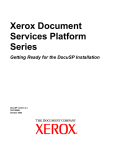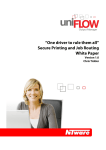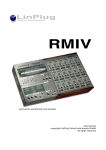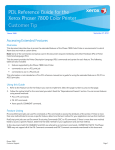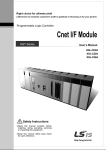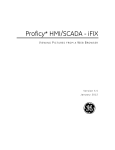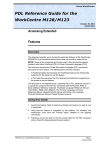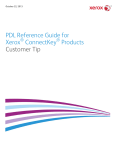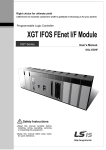Download Xerox Print Driver Platform - Fuji Xerox Printers : Home
Transcript
Xerox Print Driver Platform Xerox Global Print Driver Xerox Mobile Express Driver Contents 2 3 4 5 6 7 8 9 10 11 12 13 14 15 16 Executive summary Background information Xerox Print Driver strategy Xerox Global Print Driver (X-GPD) Xerox Mobile Express Driver (X-MED) What’s New in the Release Driver type comparison Basic printing mode Driver security Features Appendix A: (FAQ) Print Driver strategy Appendix B: (FAQ) X-GPD Appendix C: (FAQ) X-MED Appendix D: X-GPD configurations Appendix E: Tested and supported environments June 2011 Xerox Print Driver Platform Executive Summary Xerox Corporation developed a breakthrough print driver platform that significantly reduces costs and increases the efficiencies of enterprise printer management and support. This new platform has changed the way that IT administrators view and manage enterprise print drivers. Our core driver platform (the key component of this new strategy), helps make you more productive by streamlining the user interface and ensuring a consistent experience across the majority of our product lines. This consistency has greatly simplified print services delivery and reduced end-user training and support requirements, and lowered the cost of IT print services as a result. Two of the most innovative print drivers built on the new platform, the Xerox Global Print Driver and Xerox Mobile Express Driver, have been upgraded: Xerox Global Print Driver (X-GPD) is a universal print driver that offers unprecedented ease of use for network administrators managing a diverse array of print devices across the enterprise. It greatly reduces the time and effort required to deploy and upgrade print drivers on a network. Xerox Mobile Express Driver (X-MED) allows mobile professionals to quickly and easily find and use printers in any new location, without timeconsuming driver installation and costly support calls. Unlike proprietary “universal” print drivers, X-GPD and X-MED support both Xerox and non-Xerox printers, which is an important advantage for IT managers administering the typically diverse mix of print devices on today’s enterprise networks. These drivers also support 100 percent of the feature sets of most Xerox printers. In addition, X-GPD and X-MED provide you with a consistent single interface for all printers, with real-time, dynamic reports of printer status. As a result, you can easily identify the best printer for your needs, quickly choose the correct options, and see updated consumables status without the assistance of IT. Page 2 of 25 Xerox Print Driver Platform Background Information Traditional Print Drivers: The “One Driver, One Printer” Model In the typical, “traditional” scenario, print drivers are device-specific. While they can manage a single device or family of related models, traditional drivers generally can’t be used to manage other printers, particularly from other manufacturers. Most enterprise networks have diverse output requirements and employ a wide array of devices with varying capabilities. Some are connected to the network; others connect directly via USB to individual users’ computers. The task of qualifying, installing, and managing those drivers can be a large drain on an organization’s IT resources. In addition, this standard “one driver, one printer” model can proliferate drivers on a single print server, increasing the chances of conflicts between drivers. The multitude of drivers can also slow down migrations to new technology, delay recovery in the event of a disaster, and significantly increase network-operations staffing requirements. Also, making changes to a printer or its configuration can require repeated, direct interaction with users’ computers, which slows down device refreshes and increases IT’s support costs. Printer users can be confused by differences between varying print driver interfaces, which not only reduces employee productivity but also increases the need for additional training and/or help desk support. Traditional drivers often are problematic for today’s mobile professionals. When visiting a new location you must identify and install drivers in order to print documents, or interrupt onsite personnel for “print favors.” Your printer list soon grows to an unmanageable level, regardless of whether the listed printers are actually available. Printing with Universal Print Drivers A single “universal” driver platform for all networked devices resolves many of the issues that arise from the “one driver, one printer” model. A universal print driver (UPD) provides users and network administrators with a single driver interface that communicates with multiple printers. By deploying a UPD on the network, IT managers reduce printer support requirements, install or upgrade printers in a fraction of the time, and reduce the labor and overhead needed to support network printing. This cuts an organization’s overall printing costs, and increases user satisfaction with IT’s print services. Unfortunately, older UPDs are proprietary, providing little or no support for other manufacturers’ devices. The UPD may not be capable of printing to any device it doesn’t explicitly support (even from the same manufacturer), and may not always allow access to all the device’s features and capabilities. For example, the UPD may not offer access to advanced color management options or print quality settings for a selected printer, even in the manufacturer’s own product line. Proprietary UPDs are of limited usefulness in supporting the diverse array of output devices found on today’s networks. It’s not always clear if these drivers will scale to accommodate future printers and multifunction devices when a company’s product direction changes. Moreover, current UPDs fail to address mobile user issues. Because they usually can’t provide dynamic, location-specific updates of printer status and availability, you can mistakenly send documents to printers at other sites. This is frustrating and inconvenient and, when confidential documents mistakenly print in a remote location, introduces a potential security risk. Page 3 of 25 Xerox Print Driver Platform Xerox Print Driver Strategy Xerox Windows Driver Platform The Xerox Windows Driver Platform solves many of the problems of older, proprietary UPDs by providing an underlying driver base that unifies a common user experience and feature implementation. The Xerox Windows Driver Platform is the basis for our continuing delivery of traditional, universal and mobile print drivers. It also improves the user experience through enhanced ease-of-use and the ability to present a common user interface for all supported devices. Built on industry-standard UNIDRV and PScript core driver components from Microsoft, the Xerox Windows Driver Platform supports Xerox Office and Production products including our Phaser, WorkCentre, ColorQube and DocuSP/FreeFlow devices. It provides a common driver implementation for Microsoft Windows operating systems, including 32- and 64-bit versions of Windows XP SP3, Windows Server 2003 SP2, Windows Vista, Windows Server 2008, Windows 7, and Windows Server 2008 R2. Architecture The Xerox Windows Driver Platform enables a wide range of workflows from a common driver core. This simplifies driver certification in enterprise environments, and also significantly reduces or eliminates the effort required to transition between driver types. The Xerox Global Print Driver (X-GPD) is one of the first truly universal print drivers. Along with the Xerox Mobile Express Driver (X-MED), it shares the same architectural components as traditional Xerox drivers. As a result, all Xerox drivers built on this platform present a consistent user experience regardless of the chosen printer. Users will see the same features and behaviors, the same interface components, and the same driver/application interactions. These driver solutions allow users to print to almost any Xerox or non-Xerox device even when not explicitly supported. X-GPD lets IT managers virtually eliminate the one printer, one driver model, which dramatically streamlines print driver management across the enterprise. Because the three driver types share the same core and feature implementations (creating a common print driver base), IT staff need only focus on the unique changes in workflow characteristics, driver improvements or version changes when transitioning between driver types. This eliminates the need to fully test and certify multiple drivers for multiple devices, which significantly reduces IT support costs. Integration with Microsoft Core Drivers We chose to strategically align with Microsoft’s print driver development architectures, basing our platform on Microsoft’s core drivers, UNIDRV and PScript, to ensure that our drivers maintain optimal compatibility with the Windows operating system. Consistent Interface Lowers User Learning Curve Each driver offers distinct workflows tailored to meet the needs of specific types of users. Because the drivers share a consistent user experience, users can move between drivers and printers without confusion, thereby greatly reducing the need to call IT for printer support. An employee can install X-MED, for example, and find each feature in the same position in the user interface for every printer they use. Page 4 of 25 Xerox Print Driver Platform Xerox Global Print Driver (X-GPD) The Xerox Global Print Driver (X-GPD), which launched in 2008, has been significantly upgraded with the 2010 launch of version 2.0. As with the earlier version, X-GPD 2.0 reduces the burden of network printer support for IT administrators by providing broad device support in a convenient, single-driver package. It works with virtually all Xerox-branded printers and multifunction printers (MFPs), and also supports non-Xerox devices that implement print features using compliant PostScript® and PCL® page description languages (PDLs). X-GPD Key Features Unified, universal driver. Single driver can be used across the network with Xerox and non-Xerox devices using PostScript® and PCL PDLs. Simplified device management. Printers can be upgraded or replaced without requalification or reinstallation of print drivers. Custom printer settings. IT managers can deploy global, pre-configured printer settings to all X-GPD-supported devices. In addition, you can configure your own application-specific printer settings that will be applied to every new printer you choose. Single, consistent interface greatly improves the overall user experience. Unified, Universal Driver X-GPD supports virtually all Xerox-branded printers and multifunction printers (MFPs). Our tests have shown that it also works with non-Xerox devices if they support a Microsoft Windows implementation of PostScript (Level 2 or Level 3) or PCL 5/6. For fully supported devices, X-GPD displays the full feature set of the selected device, including such options as advanced color management and print quality settings. However, we can’t guarantee that non-standard features of every non-Xerox device will be compatible with X-GPD. Simplified Device Management X-GPD’s ability to unify and streamline print driver management can dramatically reduce ongoing network printing costs. A single instance of X-GPD can support multiple devices across the enterprise. This allows IT administrators to streamline driver testing, which optimizes the certification process. X-GPD can greatly simplify driver deployment and maintenance. When a network administrator upgrades a device with two-sided printing capabilities, for example, XGPD will dynamically update the user’s printer options to reflect the new features. A printer can be easily replaced when using X-GPD; the network administrator simply plugs in the new device and assigns it the same IP address as the old printer (or redirects the port). No additional installation or qualification is necessary. X-GPD will automatically determine which product should be associated with a print queue during printer installation, and select the appropriate user interface to use for the new device. This capability eliminates the need to distribute new printer queue mappings to users when changing or replacing printers. Instead, the change can be quickly and transparently delivered to the user environment without requiring additional user intervention. Page 5 of 25 Xerox Print Driver Platform Xerox Global Print Driver (cont.) Custom Printer Settings The architecture of X-GPD makes it easy to establish global printer settings for certain print driver features and apply them across the network. IT managers can use this capability, for example, to enforce sustainability or “green” by defaulting all print queues to use two-sided, or duplex, printing, or save money by electing a default setting of black and white instead of color. Single, Consistent Interface for Users Because X-GPD creates a consistent, easy-to-use printer interface, it can reduce user training and support. When X-GPD is first installed and enabled with bidirectional communication, it will identify the print device associated with the print queue. It then selects and displays the correct user interface and feature set for the user’s chosen printer. If bi-directional communication is not enabled, or the device is not fully supported by X-GPD, the user can choose between manually configuring the print driver for a richer feature experience or using a standard basic interface. Printing with Traditional Print Drivers: The “One Printer: One Driver” Model The traditional one printer: one driver model significantly increases IT’s driver management and support burden, and is frequently a source for driver conflicts on network print servers. Most “universal” print drivers are proprietary and support relatively few devices on the typical network, doing little to resolve this issue. The breakthrough Xerox Global Print Driver significantly consolidates print driver management for both Xerox and non-Xerox printers, dramatically reducing IT management and support requirements. Page 6 of 25 Xerox Print Driver Platform Xerox Mobile Express Driver (X-MED) X-MED provides you with a simple, intuitive, and consistent interface that makes it easy to find, configure and print to the best available printer in any location. The driver is location-aware, i.e., when you log-in to a new location, X-MED initiates search-and-discovery of all available printers on your local network. X-MED displays printers found in the new location and allows the creation of a customized list of printers for each new location so you see only those available at that location. Key Features Configures itself at print time. When you select a printer, the driver automatically populates its interface with the correct options and status information for that device. Helps you find the right printer without IT. Lets you find and sort printers based on IP address, printer name, location, real-time status and other information. Automatically detects location, discovers printers and dynamically updates your printer list to reflect Xerox and non-Xerox printers in that location. Customized for each user. You can add favorite printers to the “My Printers” list and save application-specific print settings. Configures Itself at Print Time X-MED differs from the traditional drivers and X-GPD, because it configures the print driver experience at print time rather than at install time. When installed, X-MED isn’t associated with any particular device. Instead, when printing from an application, X-MED initially discovers the devices available on the network or allows you to choose from a device in the My Printers list. You can view detailed information about the device and choose the device that contains the appropriate capabilities required for the print job. After selection, the driver automatically configures its driver display to represent the chosen device. Helps You Find the Right Printer without IT X-MED uses SNMP requests to query for devices on the network, within the user’s local subnet. On connection to the network, X-MED identifies the location, queries for available printers, and populates the driver’s “Discovered Printers” pane with the printers it finds on the subnet. You can sort the list by device name, model, DNS name and IP address, and by status (see right). Previously used printers become available in the user’s “My Printers” list, with the most recently used printer appearing at the top of the list. X-MED ensures that you always know which printers are ready to accept print jobs before attempting to print to a device, reducing the frustration and delay of printing to a device that requires attention. This improves employee productivity and satisfaction with IT print services. Page 7 of 25 Xerox Print Driver Platform Xerox Mobile Express Driver (X-MED) (cont.) Automatically Detects Location X-MED incorporates an intelligent discovery that identifies when you have connected to a new network location. It lets you manage the lists of available printers in different office locations, a feature that’s particularly valuable to mobile professionals working in multiple office locations. Location-Centric Printing When you move to a different office location, building, or branch, X-MED recognizes the change in network profiles and offers to create a new location for that device. You will only see devices in your “My Printers” list that are physically in that location. When you return to a previous location, X-MED will identify a change in location and will include only the printers in that location. This eliminates the need for you to juggle a long list of print queues and try to remember which print queue to use when traveling to various locations. Additionally, X-MED displays information about the location of each of the devices it discovers. This helps you find the right printer when you’re unfamiliar with a new office. To maximize the usefulness of this feature, network administrators should be sure to configure the device with this information. By using a standardized “template” for entering the device’s location, you can be selfsufficient and more productive. Many devices, including recent Xerox models, let administrators access device settings through a web browser (as in the example below, showing a browser-based user interface for the Xerox WorkCentre 7675 MFP). By using a consistent format for specifying building, floor, and room location details, you can find devices in various office environments quickly and easily. Day 1: Visiting Minneapolis X-MED identifies the new location on connection, and automatically discovers and displays available local printers. At print time, it configures the interface to match the chosen printer. Day 2: Home in Houston Back in the home office, X-MED detects its regular location and updates its display for local Houston office printers. Page 8 of 25 Xerox Print Driver Platform Xerox Mobile Express Driver (X-MED) (cont.) Customized for Each User Once you have selected a device, that device is saved in your configured list of “My Printers” for easy identification, and can be used in future print jobs. You can even rename the printers in your list by adding a personal “custom printer name” to the description of the device. When your needs or preferences change, you can also remove unused printers from your list. You can also save selected print options for specific applications. These settings will be used by any printer you choose, whenever you print from that application. For example, you could choose to print all PowerPoint presentations as handouts, in color, and save those settings. X-MED will subsequently default to printing all of your future PowerPoint presentations as color handouts, regardless of printer or location. Page 9 of 25 Xerox Print Driver Platform Driver Type Comparison Capability Traditional Xerox Driver X-GPD X-MED Driver is configured to use device feature set At Installation At Installation At Print Command • • • • • • • • • • • • • • • • • • • • • • • • • • Presents all device features using consistent user interface Groups commonly used features on first tab for easy access and enhanced usability “Saved Settings” feature allows each user to customize driver’s default settings Saves application-specific driver settings and applies to all printers selected, even non-Xerox printers Rich status reporting provides quick view of current device status; users know if a device isn’t ready before they print Configures all installable options automatically All changes to device configuration dynamically update in all user’s drivers Permits basic printing to any standardscompliant PostScript device* Permits basic printing to any standardscompliant PCL5/PCL6 device* IT can certify and deploy one driver for many devices IT can replace or upgrade printers without reinstallation of driver (simply redirect port or use same IP address as old device) User personalizes device list management per location Shows device status and capabilities prior to selection Enables quick and easy selection of the right device during print job setup • • • • *Xerox cannot guarantee print quality or feature compatibility when printing to non-Xerox devices. Page 10 of 25 Xerox Print Driver Platform Basic Printing Mode When X-GPD and X-MED encounter a Xerox device or devices from non-Xerox manufacturers that are not fully supported by the new driver platform, they will automatically fall back to basic printing mode. Basic printing mode ensures flexibility in supporting a diverse array of output devices across the network. X-GPD supports standard PostScript and PCL commands (X-MED is PostScript-only). The drivers can detect the printer’s ability to support color vs. monochrome printing, and/or two-sided printing functionality, and will present those as customized options in the driver interface. Basic printing mode also supports most of the drivers’ key features, including the ability to save application-specific print driver settings. The following table lists and describes some of the commonly used driver features in basic printing mode. Feature Description Media size Media type* Presents commonly available paper sizes. Includes various media types. Two-sided printing Detects the ability of the device to support twosided printing and then displays the appropriate options. Output color Detects the device’s ability to print in color vs. monochrome, and displays the appropriate options. If the device’s color capabilities can’t be determined by the driver, the PS driver will default to monochrome with the Output Color option, while the PCL drivers will default to monochrome printing and disable the Output Color feature. Pages per sheet (N-Up) Allows the user to place up to 16 images on one page. This environmentally friendly option helps reduce paper consumption. Booklet layout Automatically re-orders and lays out pages in the print job to form a booklet. Page layout options Watermark Presents advanced functionality to customize the layout and appearance of the printed job. Allows user to incorporate a text or graphical watermark into the print job document. *For best results, choose the media size and type offered by your device. Vendors’ implementations of media options can differ substantially and the behavior of these features is dependent on how the device supports paper sizes, paper path dimensions, media types and paper tray designations. Please consult your device’s documentation for additional information. Page 11 of 25 Xerox Print Driver Platform Driver Security Microsoft Windows operating systems check drivers for the presence of a digital signature before allowing installation and deployment to proceed. A digital signature is applied to the print driver package, certifying the security and robust behavior of the installed device. A digital signature also indicates that the driver package is intact and in the original form intended by the manufacturer, with no evidence of tampering. If the signature is missing from a driver package, Windows will alert the user, giving them the chance to abort the installation. Both the X-GPD and X-MED have been digitally signed with a Microsoft certificate in accordance with the Windows 7 Logo (WHQL) program. The web installer is signed through the use of a VeriSign digital certificate. The presence of the VeriSign digital signature indicates that the installer is intact and safe for use. Type of Driver Traditional Xerox driver Xerox Global Print Driver Xerox Mobile Express Driver Type of Digital Signature Microsoft Windows 7 Logo Program VeriSign (WHQL) • • • NA NA NA Page 12 of 25 Xerox Print Driver Platform What’s New in this Release X-GPD / X-MED Version 2.1 Enhancements: Forward compatibility (DCP). Expanded coverage of devices available via DCP updates. Online and Offline help. Users can access product-usage information and troubleshooting assistance directly from the X-GPD interface. For users with no internet access, or to reduce traffic to the public web, SA’s can download a self-extracting help files to a trusted server. Files are posted under documentation. Dynamic pre-configuration. Expanded coverage of features that can be managed for pre-configuration. IT administrators can proactively and dynamically change “pushed” driver settings, which avoids driver reinstallation and maintains MS certification. Please contact Xerox support for detailed information regarding this feature and its utility. Updated Earth Smart Interface. Earth Smart selections are now easier to use, and have expanded to estimate sheets saved when selecting duplex Enabled versioning for easier rollout. IT adminstrators can now select an alternately named GPD. The versioning enables departments to test,and rollout the GPD on a slower cadence without upgrading the previous version. Earth Smart The earth smart feature enables users to quickly set controls that will reduce the number of pages within a job by removing banner sheets, enabling duplex, and/or enabling a simplified N-up page selection. The Printer Driver provides two access points for the user to modify the Earth Smart settings. The first access point is the green Earth Smart button located in the lower left corner of Paper/Output tab. The second access point is the Earth Smart Settings Setup button located in the Driver Defaults folder of the Advance Tab. The printer driver will not display the Off Tab Earth Smart button if the user has checked the “Hide earth smart setting button” checkbox in the Earth Smart Settings window. This checkbox does not hide the Earth Smart Settings Setup button in the Advance Tab. Saved Sheets. If you enable the Earth Smart features that reduce the number of sheets to be printed, an estimated accumulative total is displayed for your printer. Page 13 of 25 Xerox Print Driver Platform Appendix A FAQ: Xerox Driver Platform Strategy Q. Does the releases of the Xerox Global Print Driver and/or Xerox Mobile Express Driver mean that the traditional Xerox print drivers will be discontinued? A. No. These drivers are additional solutions that you may choose to use in place of traditional Xerox drivers. This allows you to select the driver type that best meets your printing needs. Q. Must I choose which type of driver to use during the install process? A. No, you can easily move from traditional Xerox drivers to X-GPD or X-MED after installation. We make all three driver types readily available for download from Xerox.com as independent packages. Each driver type is clearly named to help you distinguish between them. Q. Do X-MED or X-GPD support USB devices? A. Yes. All three driver types, X-MED, X-GPD, and traditional Xerox drivers, support USB installations. Caution: In some cases, when using Windows Vista, the drivers provided with the operating system will be selected as the preferred drivers for a USB printer installation. You can change this by removing those drivers from the Windows Vista driver store. (Requires administrative rights to the system). Q. I frequently use the same print driver features when printing from certain applications. Is there a way that X-MED or X-GPD can help me simplify the process of setting up a print job when printing from these applications? A. Yes. The “Saved Applications Settings” feature allows users to create customized feature profiles on a per-user, per-application basis. For example, when printing from Microsoft Outlook, you might prefer to print in black and white mode, with two-sided output and single-staple selected. When you print from Outlook using X-GPD or X-MED, or even some traditional Xerox drivers, you can make these changes in the print driver and then save them for future use by choosing Save as Microsoft Office Outlook Defaults from the Saved Settings list. When you return to Outlook and print again, the Microsoft Office Outlook default settings will automatically be applied to the print job. Q. Were the drivers tested successfully in a Novell environment? Do they support Novell iPrint? A. Yes. X-GPD and traditional Xerox drivers were tested in Novell NDPS and iPrint configurations. However, to ensure that proper device detection and automatic configuration of installable options work correctly, it is necessary to use version 5.20 or higher of the Novell iPrint client. Q. Do the new drivers support Windows Server 2008? A. Yes. Windows XP SP3, Windows Vista SP2, Windows Server 2003 SP2, Windows Server 2008, Windows 7, Windows 7 SP1 and Windows Server 2008 R2 are supported. Page 14 of 25 Xerox Print Driver Platform Appendix B FAQ: Xerox Global Print Driver (X-GPD) Q. I am planning to upgrade my older Xerox products to newer Xerox products. Can X-GPD make this device replacement easier for me and my employees? A. Yes. A few of the fantastic benefits of deploying print queues using X-GPD are the ability to change print queue attributes, have the appropriate print driver changes take effect, and eliminate the need to redeploy new print queues to users when changes of this nature take place. When the administrator alters the IP address or changes the print queue to use a different port, X-GPD detects the modification. It will attempt to identify the new device associated with that IP address or port and will update the print driver user interface to reflect that new device. For Xerox products that are included in the Windows driver platform, the print driver will take on the feature set of the new device. If the administrator has configured the queue name to use a location-specifying naming scheme it won’t be necessary to push new print queue mappings to the users or require the users’ intervention to take advantage of the device update. Q. How do I update a particular product’s print driver? If X-GPD needs to be upgraded, does that affect all printer objects and require a complete rebuild? A. If X-GPD has been used to deploy print queues for multiple products; all of those queues will be simultaneously upgraded with the underlying X-GPD. All of the queues are associated with the same driver, and when that driver changes, all of the queues are affected. Further, if the environment contains a mix of traditional and X-GPD drivers from the Xerox Windows Driver Platform, an upgrade of one of these drivers would result in the upgrade of all other related traditional and X-GPD drivers on that system, assuming that those drivers share the same version number. Under normal conditions, it should not be necessary to rebuild all of the associated printer objects when performing an upgrade. Q. Can a network administrator create standard TCP/IP ports and apply X-GPD to local queues as they wish? A. Yes. X-GPD can be used to create multiple print queues using standard TCP/IP ports. All of these queues would be enabled by a single install of X-GPD. Q. What if you have a driver issue and need to uninstall and re-install the driver? Will ALL driver objects need to be deleted? Or just the one affected product’s driver? A. In this situation, because all of the print queues are shared by one common print driver, presumably X-GPD, all of the print queues would be affected by the deletion of the driver. 5. Are there shared DLLs among the individual queues with the Xerox Global Print Driver? What happens if a DLL becomes corrupted? Can all printer queues be corrupted because the driver is a single, shared file? A. Because all print queues associated with X-GPD use the same set of driver files, all queues will be affected if those files are corrupted. Page 15 of 25 Xerox Print Driver Platform Appendix B FAQ: Xerox Global Print Driver (X-GPD) (cont.) Q. Can X-GPD be used to create multiple print queues across various Xerox products as well as other manufacturers’ products? A. Yes. X-GPD is intended to be used for the creation of multiple print queues. These queues can be configured for a variety of Xerox and non-Xerox models. Each queue would be associated with X-GPD yet retain attributes associated with the individual device and device configuration. Q. How does an IT manager use X-GPD to support non-Xerox devices? A. When installing a non-Xerox device using the Add Printer wizard, select or create the appropriate port for the device and proceed with the installation. X-GPD will recognize the installation of a non-Xerox device and automatically default to the Basic Printing Mode. If X-GPD cannot establish bidirectional communication with the device, it will also default to basic printing mode. For more information regarding which devices are explicitly supported by X-GPD, and for additional configuration details, please see appendix D. Q. How is pre-configuration handled by X-GPD? Does it support multiple configurations? This is a known problem with some universal print drivers, such as when you’re not using SNMP and have multiple device configurations for the same model. A. Since version 2.0, the X-GPD/X-MED supports multiple versions of preconfiguration. For SA’s managing multiple devices, the use of the XML configuration tool and its required updates will enable configuration management at multiple levels, and cross many devices without breaking WHQL signatures. Similarly, pre-configuring the X-GPD with certain feature defaults is accomplished just like with traditional Xerox drivers. For more information regarding how to manage the drivers in this instance, please refer to the Xerox.com customer tip at: http://www.office.xerox.com/support/dctips/dc04cc0328.pdf Q. Is this a Windows platform-only driver? A. Yes. At the present time, X-GPD currently is only available for Windows XP SP3, Windows Vista SP2, Windows Server 2003 SP2, Windows Server 2008, Windows 7, and Windows Server 2008 R2. Q. Will X-GPD work with Follow-You-Print in the Xerox Secure Access ID System? A. We have been working with Equitrac and other Xerox partners to ensure that XGPD functions well with their solutions. Because the same PDL is emitted when using X-GPD as the traditional Xerox driver, we anticipate that X-GPD will also integrate well with these solutions. This is especially true for Xerox products fully supported by X-GPD. Page 16 of 25 Xerox Print Driver Platform Appendix B FAQ: Xerox Global Print Driver (X-GPD) (cont.) Q. Does X-GPD support accounting enablement? For example, if I’ve enabled network accounting with user IDs for my multifunction printer, how will X-GPD support a user who chooses it? A. Yes. X-GPD can be configured for accounting when used with a fully supported Xerox product. This option is implemented commonly across X-GPD and traditional Xerox drivers. Q. Are there instances when X-GPD is not the best choice? A. X-GPD is most beneficial to IT for simplifying print driver certification, deployment and maintenance. It would be less helpful if you print with a single device and don’t need to create or modify additional print queues. X-GPD will work with most non-Xerox devices that implement industry-standard PostScript and PCL commands. However, if a non-Xerox device implements features in a proprietary manner and fails to support industry-standard PostScript and PCL commands, you might experience some difficulty using the driver. In such a case we recommend that you use the manufacturer’s print driver. Q. Will the Xerox Global Print Driver support future Xerox products? A. Yes. Future releases of X-GPD will include support for Xerox products that have launched since the last release of X-GPD. Q. Will I be asked to update my Xerox Global Print Driver whenever I run the installer? A. No. The intelligence built into the Xerox driver installer allows it to determine which version of a driver is installed. It will only ask you to upgrade the driver if it detects a difference in versions. Q. Can X-GPD be pushed out with a script? If so what DLL should we reference in the script? Is there one DLL for all products? A. X-GPD is very similar to traditional Xerox drivers. The methods you use to push traditional drivers out to enterprise clients can be used with X-GPD as well. Because product support is already bundled with X-GPD, there is no need to reference specific DLLs for specific products. At install time, X-GPD will detect the product associated with the port and present the appropriate driver user interface. Q. Is the Xerox Global Print Driver an appropriate driver solution for a Citrix or Windows Terminal Server environment? A. Yes. By eliminating multiple driver versions, X-GPD may be especially helpful in a Citrix or Microsoft Terminal Server environment. X-GPD helps ensure that matching drivers are present on both the server and the client, which is a commonly faced difficulty when deploying traditional print drivers in these environments. We have applied for Citrix Ready certification for X-GPD. Server 2008 Terminal Services now includes Microsoft Easy Print, which reduces the hassle of ensuring that print driver versions match on both server and clients. To learn more, visit the Microsoft Windows Server 2008 website. Page 17 of 25 Xerox Print Driver Platform Appendix B FAQ: Xerox Global Print Driver (X-GPD) (cont.) Q. I have changed the name of my print queues to refer to building locations. How can I tell which driver type I am using, X-GPD or the traditional driver? A. To determine which type of driver is in used for a particular print queue, right-click on the queue, select “Properties” and then the “Advanced” tab. The “Driver:” feature on this tab shows the print driver that is associated with the queue. Page 18 of 25 Xerox Print Driver Platform Appendix C FAQ: Mobile Express Driver (X-MED) Q. Can I use X-MED and X-GPD together? Are there instances when you don’t recommend using X-MED? A. Yes to both questions. X-GPD and X-MED do have different workflows and are intended for different purposes. X-MED is best suited for users who require flexibility and convenience when printing, particularly when traveling. If the network environment requires strict control over printing configurations, or the user has no need to switch to different printers, there’s less need for X-MED. Q. How does X-MED employ specific protocols when sending print jobs? A. X-MED uses a local port to enable print job transmission. The user doesn’t need to manage the selection of settings such as port 9100 vs. RAW. Q. Which ports need to be open on routers / switches to allow for discovery and bidirectional communications? Is there a specific port that SNMP communications use? A. SNMP uses ports 161 and 162. In addition, the devices must support SNMP v1/v2 with the community name set to “public” to discover devices when using X-MED. To prevent devices from being discovered by X-MED, change the SNMP Community Name on those devices to use a name other than “Public” or enable the IP Filtering feature that is available on most Xerox devices. Q. I clicked on the discovery icon in X-MED, but the printer I’m looking for didn’t show up in the “Discovered Printers” list. Why? A. X-MED’s discovery module uses SNMP requests to query for devices on your network, within your local subnet. If your network is very large with numerous print devices, you may need to run the discovery module more than once to find the printer(s) you’re looking for. This is due to inherent limitations in the SNMP protocol. To force additional device discoveries, select the “Cancel” button from within X-MED and then re-open the driver by choosing “Properties” again from the application’s Print dialog. (Another way to do this is to select any device from the “Discovered Printers” list, click the “OK” button, and then click the “Change Printer” button. You can then click the Discovery icon to launch the discovery module and find additional printers.) If your printer is on a different network subnet than your PC, you’ll need to find it using X-MED’s Advanced Network Search feature. Click the “Advanced Search” button in the “Discovered Printers” window, and then specify the printer’s IP address, or specify the device’s gateway and subnet mask. You can also search for your printer directly by clicking on the “IP Address or DNS Name” button. Enter the printer’s IP address or DNS name into the resulting window, click the Search button and the driver will attempt to establish communication with the device and return its status. Page 19 of 25 Xerox Print Driver Platform Appendix C FAQ: Xerox Mobile Express Driver (X-MED) (cont.) Q. X-MED displays a long list of discovered devices. Is there any way I can filter the list to make it easier to find the printer I want? A. X-MED lets you search for printers from both the “My Printers” list and “Discovered Printers” list views. For example, type “8860” into the search field that is next to the magnifying glass icon and the results will include all devices that contain “8860” in their device or model name field. The list is dynamically filtered to react to the characters typed in that field. Q. Can I use accounting with X-MED? A. No. X-MED is not meant to be permanently associated with a particular device. Therefore, features such as accounting, or manual configuration of installable options are not supported by X-MED. X-GPD or the traditional driver for the device would be a more suitable choice in those situations. Q. Are there instances when X-MED is not the best choice for a non-Xerox device? A. Yes. X-MED will work with most non-Xerox devices that implement industrystandard PostScript commands. However, if a non-Xerox device implements features in a proprietary manner and fails to support industry-standard PostScript commands, you might experience some difficulty using the driver. In such a case we recommend you install the manufacturer’s print driver. Q. Is X-MED only a Windows platform driver? A. Yes. X-MED will only be available for Windows XP SP3, Windows Vista SP2, and Windows 7. Q. Will there be a MAC or UNIX version of X-MED in the future? A. The Xerox Mac and Linux / UNIX print drivers also enjoy the benefits of a platform approach to print driver development. As with the Windows driver platform, we work to ensure that Mac and Linux/UNIX users experience a similar user interface and consistent feature behaviors when using these drivers with a varied array of Xerox products. Appendix D: X-GPD configurations Currently, X-GPD explicitly supports the following Xerox devices: Phaser Products 3300MFP 4510 3600 5500 3635MFP 5550 4500 6250 6280 6300/6350 6360 7400 7500 7750 7760 8400 8500/8550 8560 8560MFP 8860 ColorQube (CQ) / WorkCentre (WC) / WorkCentre Pro (WCP) Products CQ 9201/9202/9203 WC 5030/5050 WC 7120 CQ 9301/9302/9303 WC 5135/5150 CQ 8570 WC 232/238 WC 5222/5225/5230 WC 7232/7242 Page 20 of 25 8860MFP Xerox Print Driver Platform WCP 232/238 WC 245/255 WC 5225A/5230A WC 5632/5638 WCP 245/255 WC 265/275 WCP 265/275 WC 5645/5655 WC 5665/5675/5687 WC 5735/5740/5745 WC 7328/7335/7345/7346 WC 7425/7428/7435 WC 7535/7545/7555 WC 7655/7665/7675 WC 7755/7765/7775 WC C2424 WC 4150 WC 4250 WC 4260 WC4600/4620 WC3550 WC 5790 WC 6400 WC 5755/5765/5775 WC M35/M45/M55 WCP 35/45/55 Continuous Feed Products DocuPrint 350 DocuPrint 525/525MX DocuPrint 425 DocuPrint 700 DocuPrint 495 DocuPrint 850 DocuPrint 1000 DocuPrint 1050/1050MX Xerox 650/1300 DocuPrint 500 iGen / High Entry Production Color DocuColor 5000 Digital Press DocuColor 5000AP Digital Press DocuColor 7000/8000 Digital Press iGen3 110 - Digital Production iGen3 90 - Digital Production iGen4 Press Mono High End Cut Sheet DocuPrint 100/100MX Enterprise Printing System and PowerPlus Series DocuPrint 115/115MX Enterprise Printing System and PowerPlus Series DocuPrint 135/135MX Enterprise Printing System and PowerPlus Series DocuPrint 155 Enterprise Printing System DocuPrint 180/180MX Enterprise Printing System and PowerPlus Series DocuTech 128/155/180 HighLight Color System DocuTech 128/155/180 Highlight Color Publisher DocuTech 6100/6115/6135 Production Publisher and PowerPlus Series DocuTech 6155/6180 Production Publisher and PowerPlus Series Nuvera EA Digital Production System Nuvera 100/120/144 EA Production System Nuvera 100/122/144 Digital Perfecting System Nuvera 288 EA Perfecting Production System Nuvera 288 Digital Perfecting System Mono Light Production Xerox 4110 / 4590 Enterprise Printing System Xerox 4110 / 4595 Copier/Printer Xerox 4112/4127 Enterprise Printing System DocuColor 240/250 DocuColor 242/252/260 with Xerox FreeFlow DXP260 Xerox Color 550/560 FFPS Xerox 700 Digital Color Press with Xerox FreeFlow Print Server Xerox 800/1000 Digital Color Press with Xerox FreeFlow C800P, C1000P Appendix D: X-GPD configurations (cont.) Fuji Xerox Products -Devices for Asia Pacific region excluding JapanApeosPort-IV C5570/C4470/C3370/C3371/C2270 DocuCentre-IV C5570/C4470/C3370/C3371/C2270 DocuCentre-IV C2260 ApeosPort-III C3300/C2200/C2201 DocuCentre-III C3300/C2200/C2201 Page 21 of 25 Xerox Print Driver Platform X-GPD supports the following Fuji Xerox devices in Fuji Xerox ApeosPort Device mode - Devices for Asia Pacific region excluding JapanApeosPort-III C7600/C6500/C5500 ApeosPort-III C4400 DocuCentre-III C7600/C6500/C5500 DocuCentre-III C4400 DocuCentre-III C4100/C3100 DocuCentre-III 3007/2007 ApeosPort-II C7500/C6500/C5400 ApeosPort-II C4300/C3300/C2200 DocuCentre-II C7500/C6500/C5400 DocuCentre-II C4300/C3300/C2200 ApeosPort-II 7000/6000 ApeosPort-II 5010/4000/3000 DocuCentre-II 7000/6000 DocuCentre-II 5010/4000 DocuCentre-II 3005/2055/2005 FX 4127/4112 DocuPrint C4350 DocuPrint C2255 ApeosPort-IV C7780/C6680/C5580 DocuCentre-IV C7780/C6680/C5580 ApeosPort-IV C4430 DocuCentre-IV C4430 DocuPrint CM505 da DocuPrint C5005 d DocuPrint 340A-AP/240A-AP DocuPrint C3290 FS -Devices for JapanApeosPort-IV C5570/C4470/C3370/C2270 DocuCentre-IV C5570/C4470/C3370/C2270 DocuCentre-IV C2260 ApeosPort-III C7600/C6500/C5500 ApeosPort-III C4405 ApeosPort-III C3305/C2205 DocuCentre-III C7600/C6500/C5500 DocuCentre-III C4405 DocuCentre-III C3305/C2205 ApeosPort-III 7000/6000/5000 ApeosPort-III 4000/3010 DocuCentre-III 7000/6000/5000 DocuCentre-III 4000/3010 DocuPrint C3360 DocuPrint 5060/4060 DocuPrint 4050 ApeosPort-IV C7780/C6680/C5580 DocuCentre-IV C7780/C6680/C5580 DocuPrint C3100/C3000 DocuPrint C3350 DocuPrint C5000 d ApeosPort-II C4300/C3300/C2200 DocuCentre-II C4300/C3300/C2200 Page 22 of 25 Xerox Print Driver Platform Appendix D: X-GPD Configurations (cont.) We recommend setting up the Xerox Global Print Driver on your network using the corresponding model from X-GPD’s supported printer list and following the on-screen directions for printer installation. In a few exceptions, however, such as when a Xerox device does not appear in the list of devices, we recommend using the following configuration choices: Device Recommended X-GPD Configuration Phaser 790 Select Basic Printing Mode PostScript/PCL not supported; use the device’s supplied driver Phaser 3124 Phaser 3130/Phaser 3150/ Phaser 3450 PostScript and PCL6 not supported; use X-GPD PCL5 in Basic Printing Mode Phaser 3500 Phaser 4400 Select Basic Printing Mode Select Basic Printing Mode Phaser 6120/Phaser 6125 PostScript/PCL not supported; use the device’s supplied driver Phaser 6130 Phaser 6180/6180MFP Select Basic Printing Mode Select Basic Printing Mode Phaser 6200 Phaser 7300 Select Basic Printing Mode Select Basic Printing Mode Phaser 8200 Phaser 6100/ Phaser 6110/ 6100MFP/Phaser 6115 MFP Select Basic Printing Mode PostScript/PCL not supported; use the device’s supplied driver Phaser EX7750 Document Centre 402/425/426 /430/432/440/460/470/480/490/535 /545/555 Select Basic Printing Mode WorkCentre M165/M175/ Pro 165/Pro 175 WorkCentre 123/128/133 Select Xerox WorkCentre Device Select Xerox WorkCentre Device Select Basic Printing Mode WorkCentre 7132 WorkCentre 7228/7235/7245 Select Basic Printing Mode Select Basic Printing Mode DocuColor® 12 DocuColor® 2045 Select Xerox FreeFlow Device Select Xerox FreeFlow Device DocuColor 2060 DocuColor 5252 Select Xerox FreeFlow Device Select Xerox FreeFlow Device DocuColor 6060 DocuPrint 525 Select Xerox FreeFlow Device Select Xerox FreeFlow Device DocuTech 65/75/90 Select Xerox FreeFlow Device Select Basic Printing Mode (Please note: Device must support PS and/or PCL) Non-Xerox devices Page 23 of 25 Xerox Print Driver Platform Appendix E: Tested and Supported Environments Xerox Global Print Driver Microsoft Windows XP / Windows Server 2003 Windows XP SP3 32-bit, including Home and Professional Editions Windows Server 2003 SP2 32-bit Edition, including Terminal Server Windows XP SP3 Professional 64-Bit Edition Windows Server 2003 64-Bit Edition, including Terminal Server Microsoft Windows Vista Windows Vista SP2, including Home Basic, Home Premium, Business and Ultimate Editions Microsoft Windows 7 / Windows Server 2008 R2 Windows 7 including Starter, Home Premium, Business and Ultimate Editions Windows Server 2008 R2, including Standard, Enterprise and Data Center Editions Microsoft Windows Cluster Windows Server 2003 SP2, 2008, and Server 2008 R2 Microsoft Point & Print (including Active Directory) Windows Server 2003 SP2, 2008, and Server 2008 R2 Microsoft IPP Microsoft RDP & HTTP Novell Novell Netware 6.x: NDPS, NDS, iPrint (5.2 or greater) Citrix XenApp Printer Description Languages PostScript (Level 2 & 3) PCL5c/5e and PCL6 (2.x, 3.x) Xerox Mobile Express Driver Microsoft Windows XP Windows XP SP3 32-bit, including Home and Professional Editions Windows XP SP3 Professional 64-Bit Edition Microsoft Windows Vista Windows Vista SP2, including Home Basic, Home Premium, Business and Ultimate Editions Microsoft Windows 7 Windows 7, including Starter, Home Premium, Business and Ultimate Editions Printer Description Languages PostScript (Level 2 & 3) Page 24 of 25 Xerox Print Driver Platform To learn more, visit us at www.xerox.com/mobileexpress (X-MED) and www.xerox.com/global (X-GPD) Copyright © 2008-2010 Xerox Corporation. All rights reserved. Contents of this publication may not be reproduced in any form without permission of Xerox Corporation. XEROX® and the sphere of connectivity design are trademarks of Xerox Corporation in the U.S. and/or other countries. All other trademarks are the property of their respective owners. The information in this white paper is subject to change without notice. 9/10 610P729751 SFTWP-02UC Page 25 of 25

























